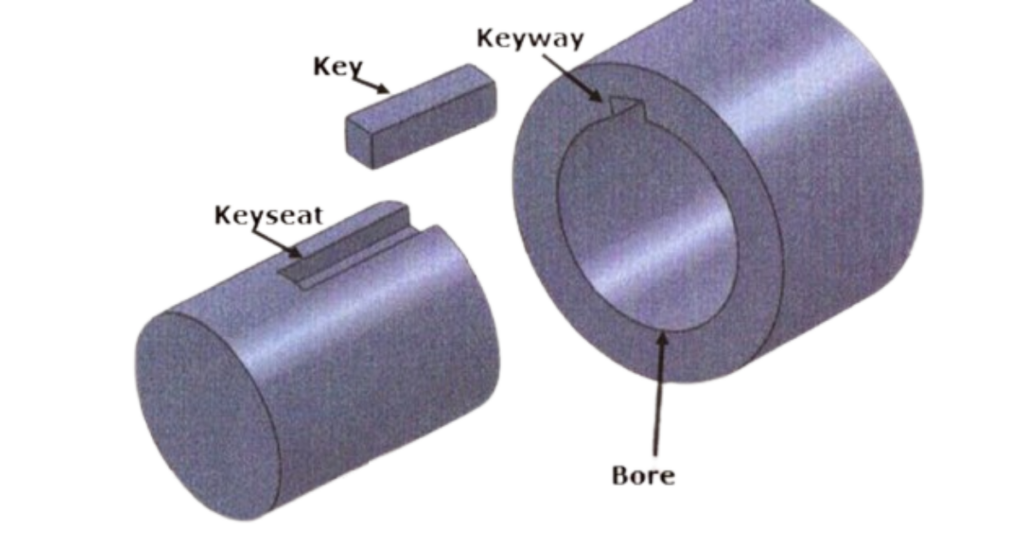In the complex machinery system that drives the world around us, there is a vital connection between shafts and keys—a partnership that is often overlooked but essential for the smooth functioning of mechanical systems. These components work together to transfer power, keep everything aligned, and ensure that different parts move in sync.
Let’s dive into the world of shafts and keys, uncovering the importance of their connection and the balance they bring to the mechanical symphony.
Shafts

- Function: A shaft is a long, cylindrical rod designed to transmit rotational motion and torque. Found in engines, gear systems, and various machinery, shafts serve as the backbone of rotational power transmission.
- Materials: Shafts are typically crafted from durable materials such as steel, alloy steel, or stainless steel, depending on the application’s specific requirements.
- Types: Shafts come in various shapes and sizes, including straight, stepped, and splined shafts, each tailored to meet the demands of different mechanical systems.
Keys

- Function: Keys are small, often wedge-shaped components used to connect rotating elements, such as gears or pulleys, to a shaft. Their primary role is to prevent relative motion between the shaft and the connected part.
- Materials: Keys are commonly made from materials like carbon steel or stainless steel, chosen for their strength and resistance to wear.
- Types: Common types of keys include parallel keys, Woodruff keys, and taper keys, each designed for specific applications and load requirements.
The Key and Keyway Connection

- Keyway: A keyway is a slot or groove machined into the shaft to accommodate the key securely. This ensures a snug fit, preventing slipping or rotation between the shaft and the connected part.
- Types of Fit: Keys provide either a clearance fit, where a slight gap exists between the key and keyway, or an interference fit, where the key is slightly larger than the keyway for a tight, secure connection.
Shafts and Keys Working Together
Shafts and keys are partners in a mechanical tango, working together to transmit power and prevent components from spinning out of control. Imagine the shaft as a sturdy axle, like the metal rod holding a bicycle wheel. It’s the backbone of the movement, rotating to drive various machinery. But on its own, the shaft can’t guarantee everything stays put.
That’s where the key steps in, acting like a precision-cut dance partner. It’s a small wedge-shaped piece of metal that fits snugly into a groove machined into the shaft, called a keyway. Think of it as a puzzle piece locking the key and shaft together.
As the shaft rotates, the key prevents it from slipping or wobbling within the connected component, like a gear or pulley. This ensures smooth, reliable power transmission, keeping your engine, bike wheels, or any other machinery running smoothly. It’s a simple yet ingenious partnership, a silent duet that keeps the wheels of the world turning!
Challenges and Solutions
- Key Wear and Shear: Continuous operation and high torque can lead to key wear and shear. Regular maintenance, proper lubrication, and the use of high-quality materials help mitigate these challenges.
- Key Slippage: In some cases, key slippage can occur due to inadequate key size or improper fit. Ensuring the correct key size and fit during assembly prevents this issue.
Maintenance and Inspection
- Regular Lubrication: Periodic lubrication of the key and keyway reduces friction, minimizes wear, and ensures smooth operation.
- Inspection for Wear: Regular visual inspections of keys and keyways help identify signs of wear, corrosion, or deformation, enabling timely replacement and preventing potential failures.
Conclusion
In the complex world of machinery, shafts and keys play a vital role, working together to ensure a smooth transfer of power and motion. As we explore the importance of this partnership, it becomes evident that the accuracy and dependability of this connection are crucial for the smooth operation of numerous mechanical systems.
In the dynamic field of engineering, the partnership between shafts and keys is constantly being improved, ensuring that the machinery that drives our modern world remains dependable and long-lasting.
For a visual guide on how to place a keyway in a shaft and then attach the pulley, watch the video below to learn the process.




